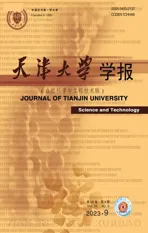海水中萘的水质基准推导及渤海湾潜在生态风险评价
2023-06-25刘宪华李佳璇李嘉垚谷春博纪志永
刘宪华,李佳璇,李嘉垚,谷春博,纪志永,孙 军
海水中萘的水质基准推导及渤海湾潜在生态风险评价
刘宪华1,李佳璇1,李嘉垚1,谷春博1,纪志永2,孙 军3
(1. 天津大学环境科学与工程学院,天津 300354;2. 河北工业大学化工学院,天津 300401;3. 中国地质大学(武汉)海洋学院,武汉 430074)
渤海湾沿岸分布着人口稠密且经济发达的城市,同时也是我国重要的海上油气开采基地,保护生态环境健康对于环渤海经济圈的可持续发展具有重要意义.以萘为代表的多环芳烃是一类在海水环境中广泛存在的持久性有机污染物,由于海上突发事故和陆源排放使其生态风险备受关注.目前,国内海水水质基准的研究较为滞后,对海水中萘的生态风险问题研究较少,尚未建立萘的海水水质基准.本研究收集了已发表的萘对海水水生生物的生态毒性数据,并对渤海环境中广泛存在的5门8科的海水水生生物进行了急性毒性试验.结合数据库甄选的文献数据和毒理试验获得的试验数据,基于物种敏感度分布(SSD)模型推导了海水中萘的短期水质基准(SWQC),并根据最终急慢性比外推的方法推导了海水中萘的长期水质基准(LWQC).采用推导的水质基准和文献中渤海湾海水表层水体中萘的实测数据,应用商值法对渤海湾及其邻近海域进行了萘的潜在生态风险评价.结果表明,基于Gumbel分布的SSD模型对数据的拟合效果最佳;利用该模型推导得到萘的短期海水水质基准为0.3014mg/L,长期海水水质基准为0.0886mg/L;正常环境条件下,渤海湾及其邻近海域水体中萘的短期生态风险和长期生态风险都处于较低水平,但不能排除突发事故中萘对水体产生的潜在生态风险.本研究作为海水水质基准推导的一个具体例子,可为渤海湾的污染防治和水生生物保护提供有价值的信息,并为其他区域海水水质基准的制定提供参考.
渤海湾;萘;长期水质基准;短期水质基准;生态风险
随着工业的快速发展以及人们对海洋资源频繁的开发利用,海洋生态环境正面临巨大的挑战.多环芳烃是一类在海水环境中广泛存在的持久性有机污染物,由于污水排放和石油污染等因素使其生态风险备受关注[1-4].萘是由两个苯环组成的最简单的多环芳烃化合物,被广泛应用于人们的生产生活,而且它也是原油中含量最高的有机物之一.近年来的研究表明,萘在海洋中的分布范围以及浓度逐渐加大[5-8].虽然萘的毒性较小,但具有高度稳定性和亲脂性,因而容易透过生物膜而诱发一系列生物学毒理效应[9].萘是美国环境保护署列出的优先控制污染物之一,同时也是我国环境优先监测的污染物之一.萘可以对生物造成不同程度的神经损伤和氧化损伤[10].例如,萘的斑马鱼胚胎毒性实验结果表明,一定浓度的萘可能对胚胎产生影响,高剂量的萘可使斑马鱼胚胎发育停滞、凝结率升高,长期生存在低毒性的萘环境中可使鱼类生长缓慢、孵化延迟、活力降低、自主活动变缓、心脏功能受损[11].
渤海湾是我国重要的海湾之一,其陆域边界为经济发达的京津唐地区,海域范围分布着储量丰富的油田,如冀东油田、大港油田和渤海油田[12].近年来对渤海湾海域中萘的监测结果表明,渤海湾中萘的浓度有增加的趋势.其原因可归因于两个方面:一方面,邻近渤海湾的沿岸陆地区域主要以工业发展为主,需要消耗大量化石能源;另一方面,渤海湾海域的石油开采也会带来污水排放和石油泄漏[13].
水质基准值是指污染物对生物或生态功能产生影响的最大容许浓度,研究萘的海水水质基准可以科学判断海洋生物萘暴露的风险,保护海洋环境免受萘的危害.目前,国内海水水质基准研究较为滞后,尚未建立萘的海水水质基准.本文采用物种敏感度分布(species sensitivity distribution,SSD)曲线法,结合利用筛选获得的文献数据和毒理试验获得的试验数据,推导了渤海湾萘的海水水质基准值.然后,对渤海湾及邻近海域萘的潜在生态风险进行了评价.本文可为渤海水生态区域化精细管理提供理论依据,并为修订海洋环境质量标准、预防和控制萘对水生生物及生态系统的危害提供科学依据.
1 材料与方法
1.1 收集和筛选毒性数据
渤海湾萘的水质基准推导数据来自于毒性数据库和文献数据库(ECOTOX、中国知网(CNKI)、Web of Science(WOS)). 在纳入的数据库中对萘毒性数据进行筛选和检索,参考《淡水水生生物水质基准制定技术指南》(HJ 831—2017)[14]从检索出的文献数据中获得萘胁迫下生物的急性毒性(EC50、LC50、IC50)和慢性毒性(NOEC、LOEC、NOEL、LOEL、MATC)的毒性效应终点.其中物种类别应该至少涵盖3个营养级,至少满足美国环境保护署规定的“3门8科”,主要以栖息或分布于渤海海洋环境的代表性海水水生生物为优选对象,确保是在适宜生长条件下测得的毒性数据.
1.2 急性毒性试验
在灭菌的人工海水中培养并选取驯养一周后活力较好的5门8科的渤海本土物种进行急性毒性试验,其中本土动物7种,本土植物1种.在正式试验前均通过预试验确定了合适的浓度范围,并验证了助溶剂的毒性.每一个急性毒性试验均设置了5个浓度梯度和1个空白对照,每个浓度梯度和空白对照分别设置3个平行.利用软件SPSS 25.0计算水生动物的LC50,利用软件Graph Pad prime 8计算小球藻的EC50.试验物种的试验条件以及物种来源的详细信息如表1所示.
表1 萘的急性毒性试验条件

Tab.1 Test conditions of acute naphthalene toxicity
1.3 水质基准的推导方法
建立海洋水质基准首先要确立水体中污染物浓度与本土生物/生态受影响的定量关系,其次满足水质基准保护海洋中大部分生物免受危害的目的[15],要获得趋近于事实的真实值必须基于毒性数据建立定值的方法.一些国家根据自身情况建立了研究方法[16],我国在探索海水中萘的水质基准的研究中尚无系统性的研究,在参考其他国家制定的基准时存在代表性过高或过低的问题[17-18].国内外的研究表明,物种敏感度分布曲线法在环境质量标准的推导和生态风险的评估中被广泛应用,本文采取此方法来探究和推导海水中萘的水质基准.
以文献检索和毒性试验获得的急性毒性和慢性毒性数据作为构建SSD曲线的基础.本文参考OECD基准推导体系[19]及我国淡水水质基准推导指南,推导过程如下.
依据式(1)和式(2)分物种计算SMAV和SMCV.


对种平均急慢性值毒性数据进行正态分布的检验.>0.05的数据符合正态分布,≤0.05的数据不符合正态分布.符合正态分布结果的,将物种SMAV/SMCV或其对数值分别从小到大进行排序,如果有两个或两个以上物种的毒性值相同,则将其任意排成连续秩次,每个秩次下物种数为1.依据式(3)计算物种的累积频率,计算式为

式中:为累积频率,%;为物种排序的等级;为物种的个数.
本研究采用EPA SSD-Toolbox软件进行SSD模型拟合,依据SSD-Toolbox软件输出的贝叶斯值()、赤池信息准则(Akaike information criterion,AIC)、贝叶斯信息准则(Bayesian information criterion,BIC)、变异系数(coefficient of variation,CV)、标准误差(standard error,SE)和MATLAB 软件计算的决定系数(2)、均方根误差(RMSE)、回归平方和(SSR)、残差平方和(SSE)等参数,优选合适的模型.
根据急性毒性数据和模型拟合结果推导短期水质基准(SWQC),由于缺乏足够的慢性毒性数据,长期水质基准(LWQC)使用最终急慢性比(FACR)推导.
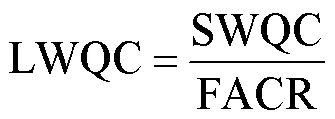
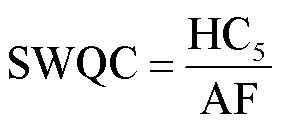


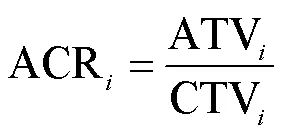
1.4 生态风险的评价方法
生态风险的评价可以用于判断在一定区域内的某种或某些污染物是否对生态系统的结构和功能造成损害.目前采用的生态风险评价方法包括商值法、物种敏感度分析法以及概率风险评价法[20-23].其中商值法是一种简单的“单点”估计的风险表征方法[24],因其可以利用最少的数据来证明低的生态风险,所以经常被使用在生态风险评价中.本文采用风险商HQ对萘的生态风险进行评估,用污染物暴露浓度(MEC)除以基准值(TRV)[25-26],TRV与水质基准(WQC)含义相同,可以计算短期和长期风险,具体方法如下:
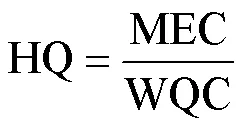
式中:HQ<0.1为不存在明显的生态风险,0.1≤ HQ<1为低风险,1≤HQ<10为中等风险,HQ≥10为高风险.
由于本文没有对渤海湾的水体进行现场实测,所以根据文献查找及数据转化获得的渤海湾天津近岸海域区域萘的暴露浓度[27]作为实测浓度.所使用文献数据的采样区域均为渤海湾,采样类型为表层海水,采样点具有一定的代表性,可以用于渤海湾萘的生态风险评价.
2 结果与讨论
2.1 数据筛选结果
从符合条件的文献中检索得到满足筛选条件的毒性数据共182条.包括涵盖4门18科18属18个物种的138条动物急性毒性数据,涵盖4门4科4属4个物种的38条动物慢性毒性数据,涵盖2门2科2属2个物种的6条植物毒性数据.
2.2 毒性试验结果
对渤海湾中海洋生物进行的萘急性毒性试验,并根据急性毒性试验暴露时间的原则计算了萘对这几种海洋生物的LC50值.参考OECD淡水水质基准指南,利用平均急慢性公式(式(1)和式(2))计算,海洋生物详细的急性试验数据在表2中体现.
2.3 推导水质基准结果
2.3.1 短期水质基准
本文使用SPSS 25.0软件分别对种平均急性值(SMAV)和种平均慢性值(SMCV)的对数值(lg SMAV/lgSMCV)做正态性检验(K-S检验或D’Agostino-Pearson检验),>0.10,符合正态分布.将其对数值分别从小到大进行排序,结果如表3所示.
表2 萘对试验动物和植物的急性试验结果
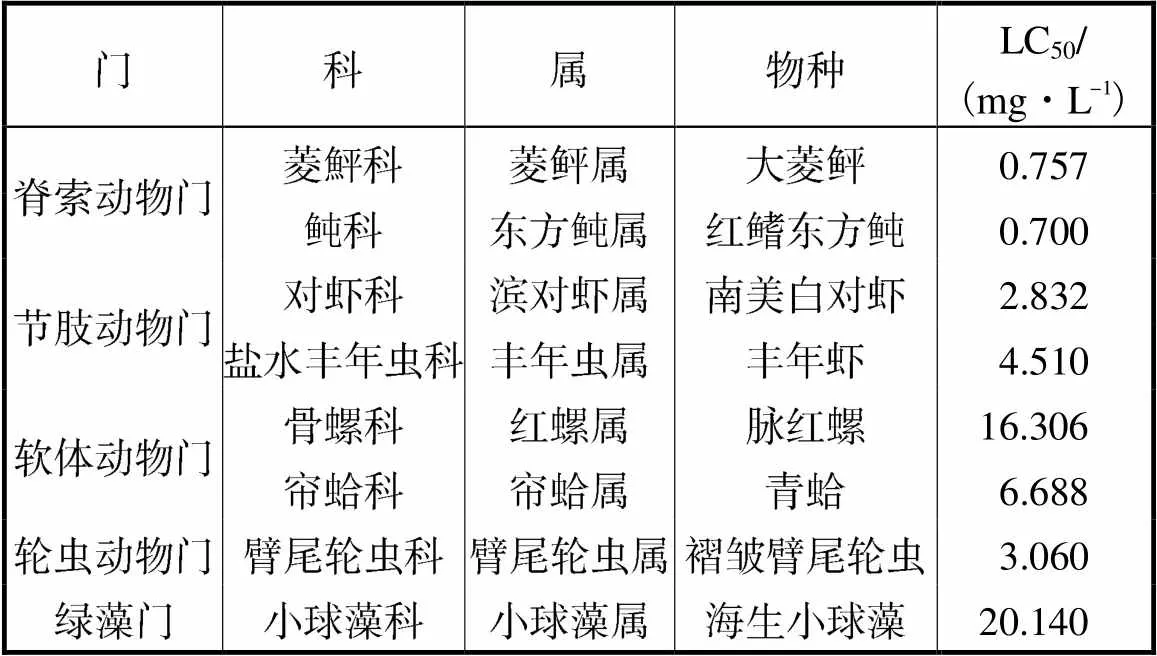
Tab.2 Test results of acute naphthalene toxicity on labo-ratory animals and plants
表3 基于物种敏感度分布法的急性毒性数据排序
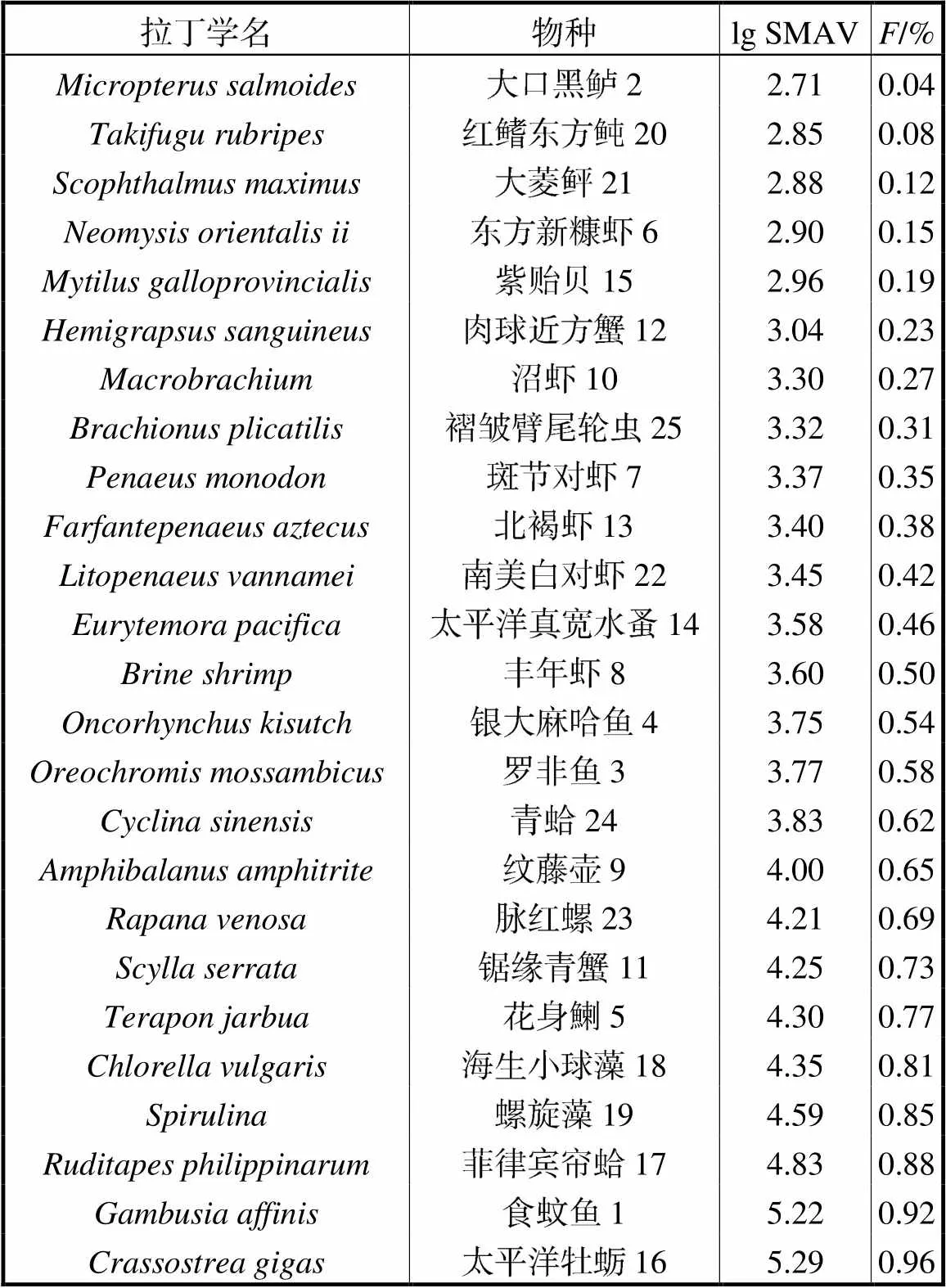
Tab.3 Ranking of acute toxicity data based on the species sensitivity distribution method
将上述实验和数据库筛选后获得的渤海湾萘的急性毒性数据(EC50或LC50),导入SSD Toolbox,分别进行基于metropolis-hastings(MH)方法和最大似然ML(maximum-likelihood)方法的Normal、Logistic、Triangular、Gumbel、Weibull和Burr 6种模型的拟合.拟合图和检验结果见图1和表4.图1中数字1~25对应表3中的物种.
对萘急性毒性数据的156条进行SSD模型拟合,根据软件输出参数的优劣,判断基于ML方法的Gumbel分布为最优拟合模型拟合的SSD曲线.
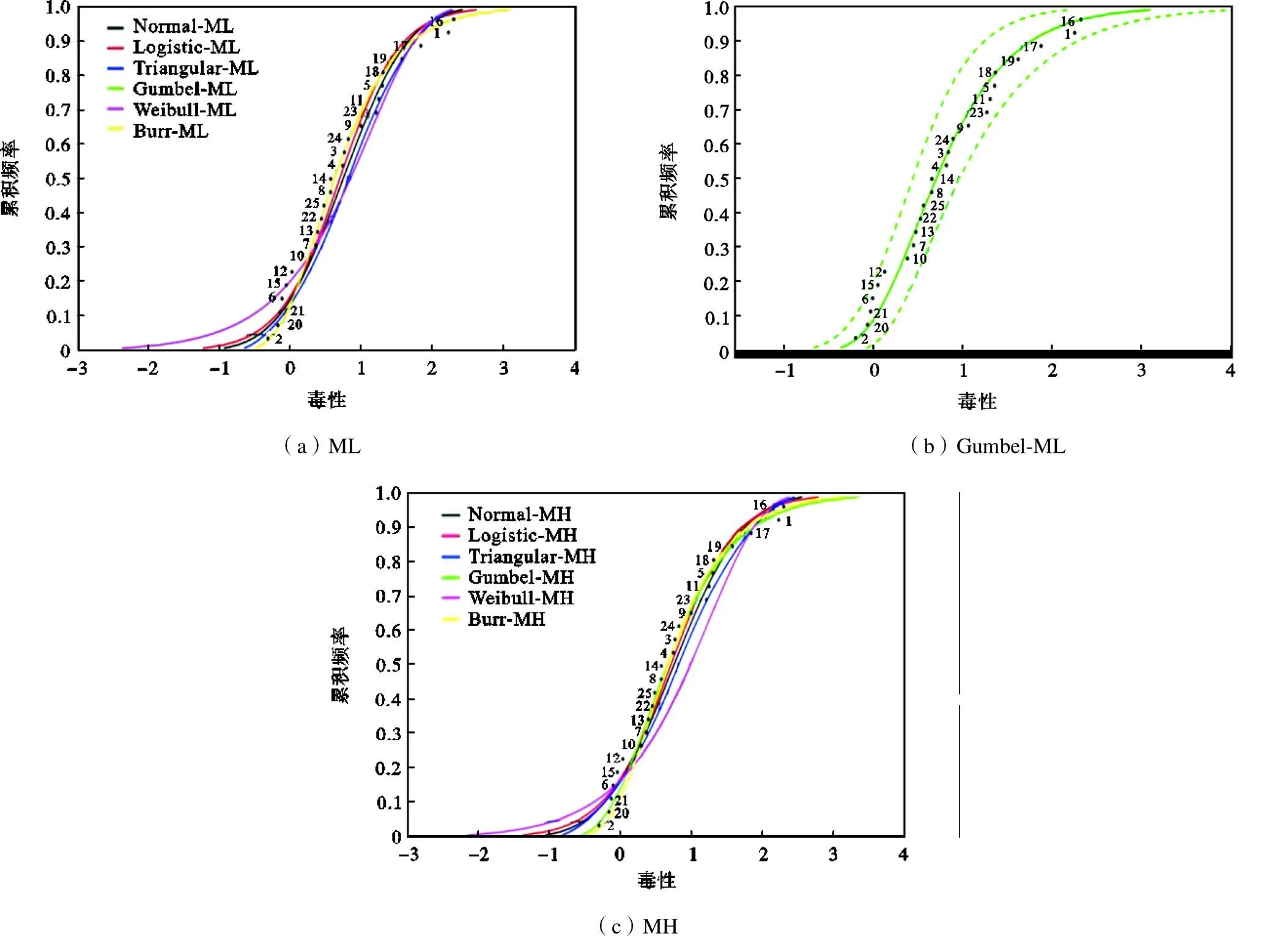
图1 渤海湾萘的短期水质基准模型拟合曲线
表4 萘的短期水质基准模型拟合结果
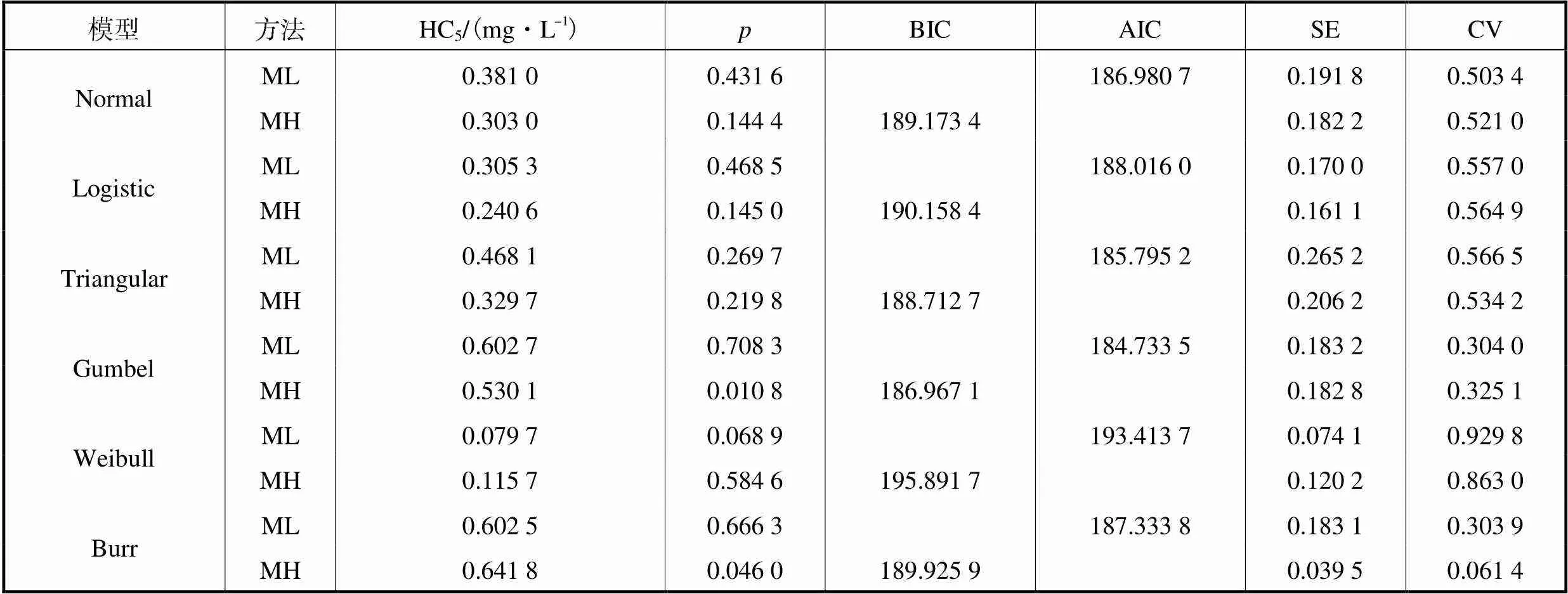
Tab.4 Fitting results of the short-term water quality criteria model of naphthalene
根据表4短期水质基准模型拟合结果得到对应的急性5%物种危害浓度HC5=0.6027mg/L.本研究中有效毒性数据的数量大于15并涵盖足够的营养级生物,评估因子取值为2.得到萘的海水水生生物短期水质基准SWQC=0.3014mg/L.
2.3.2 长期水质基准
由于本研究中萘影响下的渤海湾水生生物的慢性数据仅有4个物种,不满足美国环境保护署“3门8科”的计算条件,故采用ACR法推导长期水质基准[28].根据第1.3节式(5)~式(8)推算出萘影响下物种的急慢性比,结果如表5所示.最终,计算出长期水质基准LWQC=0.0886mg/L.
表5 基于物种敏感度分布法的急慢性比计算

Tab.5 Acute-chronic ratio calculation based on the species sensitivity distribution method
2.4 生态风险评价结果
对文献中已报道的渤海湾天津近岸海域中萘的浓度值进行分布统计,如表6所示,得到渤海湾及近岸海域中萘的平均浓度值为54.14ng/L[25,29-34].根据第1.4节中式(9)计算出的短期生态风险和长期生态风险远小于0.1,说明渤海湾中萘的污染整体属于较低的生态风险.但需要注意石油泄漏等意外情况引发的事故排放,如石油泄漏能快速增加海洋表层水和沉积物中的萘[35-38].本文采用数据转化方法得到的实测值存在一定的缺陷,简单利用推导出的基准对风险进行了初步评价,为确保渤海湾的生态安全,需要环境监测部门进一步采样测量并关注潜在污染源和海洋环境中萘的变化趋势,同时制定适当的风险管控措施以避免或减轻事故排放造成的风险.
表6 渤海湾海域表层海水中萘浓度
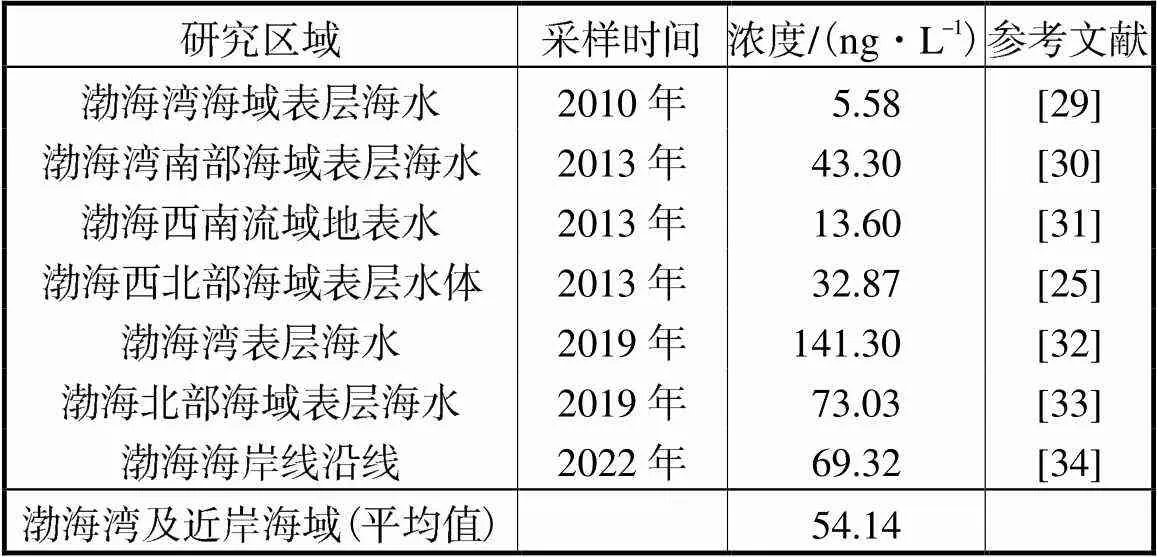
Tab.6 Naphthalene concentration in the surface seawater of Bohai Bay
2.5 讨 论
水质基准的基础研究从20世纪初已经开始[39].我国近年才开始水质基准研究,起步较晚,且基准推导以借鉴、引用其他国家水质基准理论和方法为 主[40]. 现行的《地表水环境质量标准》和《海水水质标准》在制订时主要依据的是美国、日本及欧洲等国家以及国际组织的相关水质标准和水生态基准数据,难以切实有效地为我国生态系统提供适当的保护.本文推导基准的数据源既包含严格筛选的文献数据,还包括针对渤海湾本土物种的毒性试验数据,所以保证了建立的海水水质基准能够符合我国海湾的生物特征,因而更适合我国当前海洋环境管理的需求,可以有效避免“欠保护”和“过保护”.
本文推导的萘的长期水质基准值(0.0886mg/L)大于澳大利亚和新西兰颁布的海水中萘的最大容许浓度(70μg/L),小于美国环境保护署颁布的萘的人体健康水质基准(143μg/L).由于水质基准推导方法和表征形式、使用的物种均存在差异,导致不同国家制订的萘的基准均存在一定差异(表7).1999年加拿大环境部(CCME)发布的《水生生物保护水质指南》[41]中提到海水中萘的最大容许浓度为1.4μg/L.其推导过程基于评价因子法,并规定了推导基准值时的最小数据集要求[42-43].2000年澳大利亚和新西兰颁布了《淡水和海洋水质指南》,其中规定海水中萘的最大容许浓度为70μg/L.该基准采用指导性触发值(慢性暴露,TVs)对水生生物进行保护,其推导一般采用SSD法,数据不充足时也可以用评价因子 法[44].荷兰的Kalf等[45]基于Log-Logistic概率分布模型的生态毒理学数据外推方法提出萘的最大容许浓度为1.2μg/L.2001年荷兰颁布了“关于推导环境风险限值的指导方针”,建议在推导基准时要考虑污染物的二次毒性以及在水和沉积物中的分配平衡,然后采用SSD法确定环境基准值[46].
表7 各国颁布的萘的水质基准以及推导方法
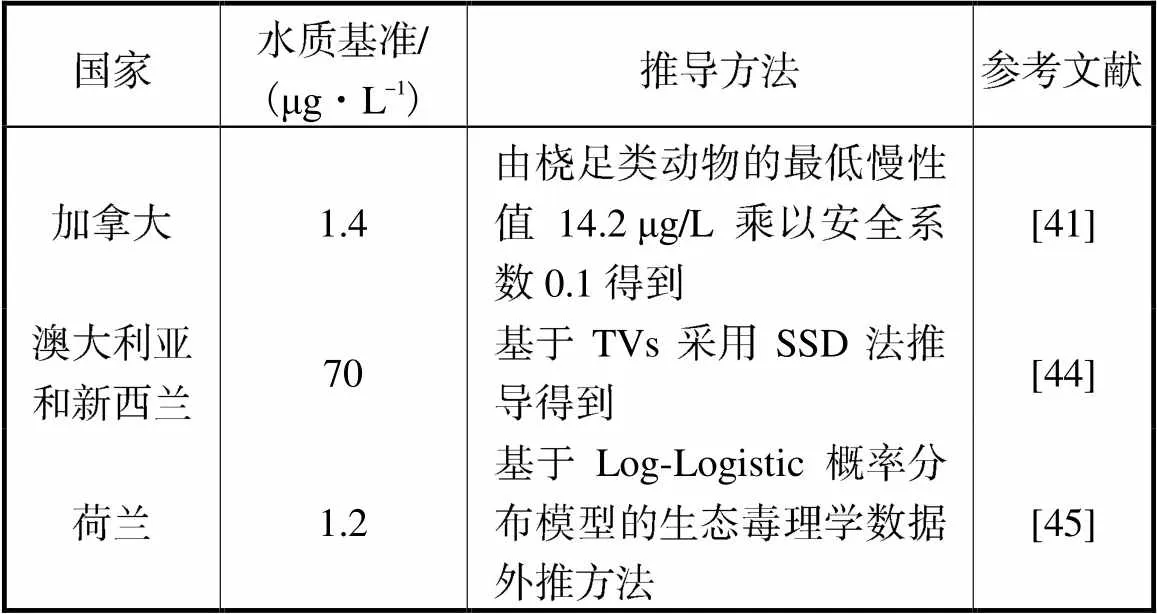
Tab.7 Water quality criteria for naphthalene promul-gated by various countries and their derivation methods
本文推导萘的水质基准采用的是SSD方法.相比于美国水质基准中常用的毒性百分数排序法,SSD方法在一定程度上能够避免或减轻了个别异常值对最终基准值的影响,更具统计学意义.另外,各个国家的水质基准体系的建立普遍采用了双值水质基准,所以本文推导的萘的海水水质基准也采用双值水质基准.其中,SWQC能预测水生生物在短期内萘高浓度的影响,LQWC能保护水生生物免受低浓度长期作用的影响.
本基准的推导中严格选用了海洋生物的毒性数据,而荷兰、欧盟等国家和地区在基准推导中未严格区分海水和淡水的差异.也有学者认为[15],由于我国海岸线较长,且沿岸分布着较多的排污口和工业区存在高浓度污染,在近岸海水与淡水、陆地的交汇处,栖息着广盐性的水生生物,所以在推导我国海水水质基准时可以包含淡水的毒性数据.曾勇等[47]推导出水生生态系统中萘的CWQC(慢性水质基准)为10.25μg/L,其毒性数据来源于ECOTOX的咸淡水数据,因此与本文推导的基准值有差异.
总体来看,不同国家以及不同学者提出的萘的水质基准值差异较大,产生差异的主要原因一方面可能是由于推导方法和采用的模型不完全相同,例如,使用评价因子法推导时计算结果相对保守,使用SSD法推导时采用不同的概率分布模型也会得到不同的结果.另一方面,即使釆用相同的推导方法,由于物种组成、毒性数据筛选、是否考虑食物链的影响等因素的不同,得到的基准也存在一定的差异.
本文虽然以萘为例初步探索了我国海水水质基准的推导方法及其在生态风险评价中的应用,但试验物种偏少,也缺乏考虑不同水体状况和气候特征、不同污染物之间的相互作用等因素的影响,建议今后可以进一步加强研究.
3 结 语
使用收集筛选的毒性数据集和水生生物毒理试验相结合,基于物种敏感度分布法推导出海水中萘的短期水质基准为0.3014mg/L,长期水质基准为0.0886mg/L.利用推导的水质基准和已报道的渤海湾萘的水质监测数据,基于商值法分析了渤海湾海水萘的生态风险,结果表明渤海湾水体萘的短期生态风险和长期生态风险较低,但在突发事件中萘的风险值得进一步关注.
[1] 梁俊华. 南中国海PAHs的分布、生物泵输出及时间序列研究[D]. 厦门:厦门大学,2014.
Liang Junhua. The Study on Distribution,Biological Pump Output and Time Series of PAHs in the South China Sea[D]. Xiamen:Xiamen University,2014(in Chinese).
[2] Ya M L,Wang X H,Wu W L,et al. Seasonal variation of terrigenous polycyclic aromatic hydrocarbons along the marginal Seas of China:Input,phase partitioning,and ocean-current transport[J]. Environmental Science & Technology,2017,51(16):9072-9079.
[3] 戴群莹,彭 娟,董旭东. 多环芳烃对人类健康影响的研究进展[J]. 重庆医学,2014,43(21):2811-2813.
Dai Qunying,Peng Juan,Dong Xudong. Research progress on the effects of polycyclic aromatic hydrocarbons on human health[J]. Chongqing Medicine,2014,43 (21):2811-2813(in Chinese).
[4] 沈国兴,严国安,余 新,等. 萘及其衍生物对普通小球藻的毒性效应[J]. 水生生物学报,1999,23(5):460-468.
Shen Guoxing,Yan Guo’an,Yu Xin,et al. The toxic effects of naphthalene and its derivatives on[J]. Acta Hydrobiologica Sinica,1999,23(5):460-468(in Chinese).
[5] 国晓春,张胜男,卢少勇,等. 鄱阳湖多环芳烃的分布、来源与风险评估[C]//持久性有机污染物论坛2018暨化学品环境安全大会论文集. 成都,2018:136-138.
Guo Xiaochun,Zhang Shengnan,Lu Shaoyong,et al. Distribution,sources and ecological risk assessment of polycyclic aromatic hydrocarbons in Poyang Lake,China[C]//Proceedings of the 2018 Persistent Organic Pollutants Forum and Conference on Chemical Environmental Safety. Chengdu,China,2018:136-138 (in Chinese).
[6] 张新庆,杨佰娟,黎先春,等. 南黄海中部海水中多环芳烃的分布特征[J]. 岩矿测试,2009,28(4):325-328.
Zhang Xinqing,Yang Baijuan,Li Xianchun,et al. Distribution characteristics of polycyclic aromatic hydrocarbons in seawater from the South Yellow Sea[J]. Rock and Mineral Analysis,2009,28(4):325-328(in Chinese).
[7] 江 晶. 萘对斜生栅藻()和铜绿微囊藻()毒性效应研究[D]. 长春:东北师范大学,2010.
Jiang Jing. The Toxic Effects of Naphthalene onand[D]. Changchun:Northeast Normal University,2010(in Chinese).
[8] 张先勇. 海口湾表层海水多环芳烃(PAHs)的时空分布及其生态毒理效应研究[D]. 海口:海南大学,2011.
Zhang Xianyong. Study on Spatial and Temporal Distribution of PAHs in Haikou Bay and the Ecotoxicological Effects on[D]. Haikou:Hainan University,2011(in Chinese).
[9] 陈 讯. 新型磁性固相萃取材料性能及其在淮河流域有机物检测中应用研究[D]. 南京:南京大学,2016.
Chen Xun. Research on Extraction Performance of Novel Magnetic Solid-Phase-Extraction Microspheres and Application in the Detection of Organic Compounds in Huaihe River[D]. Nanjing:Nanjing University,2016(in Chinese).
[10] 王隽媛,边红枫,金香琴,等. 萘对斑马鱼()内脏团抗氧化防御系统的胁迫与生物响应[J]. 环境科学,2009,30(2):516-521.
Wang Junyuan,Bian Hongfeng,Jin Xiangqin,et al. Stress and biological response of naphthalene to the antioxidant defense system in visceral mass of Zebrafish()[J]. Environmental Science,2009,30(2):516-521(in Chinese).
[11] 何 欣. 萘对斑马鱼()胚胎发育毒性效应的研究[D]. 长春:东北师范大学,2010.
He Xin. Study of Naphthalene on the Effect of Development Toxicity of Zebrafish()Embryo [D]. Changchun:Northeast Normal University,2010(in Chinese).
[12] Qian X,Liang B C,Fu W J,et al. Polycyclic aromatic hydrocarbons(PAHs)in surface sediments from the intertidal zone of Bohai Bay,Northeast China:Spatial distribution,composition,sources and ecological risk assessment[J]. Marine Pollution Bulletin,2016,112(1/2):349-358.
[13] 胡树起,汤丽玲,马生明,等. 渤海湾表层沉积物中有机污染物组成、来源及其生态风险[J]. 物探与化探,2014,38(2):309-317,324.
Hu Shuqi,Tang Liling,Ma Shengming,et al. Composition,sources and risk assessment of the organic pollutants in the surface sediments from the Bohai Gulf[J]. Geophysical and Geochemical Exploration,2014,38(2):309-317,324(in Chinese).
[14] 中华人民共和国生态环境部. HJ 831—2017 淡水水生生物水质基准制定技术指南[S]. 北京:中国环境科学出版社,2017.
Ministry of Environment Protection of the People’s Republic of China. HJ 831—2017 Technical Guideline for Deriving Water Quality Criteria for the Protection of Freshwater Aquatic Organisms[S]. Beijing:China Environmental Science Press,2017(in Chinese).
[15] 穆景利,王菊英,洪 鸣. 海水水质基准的研究方法与我国海水水质基准的构建[J]. 生态毒理学报,2010,5(6):761-768.
Mu Jingli,Wang Juying,Hong Ming. Methods of deriving marine water quality criterion and proposal for establishment of national marine water quality criterion in China[J]. Asian Journal of Ecotoxicology,2010,5(6):761-768(in Chinese).
[16] 康凯莉,管 博,李正炎. 中国近海环境中汞的水质基准与生态风险[J]. 中国海洋大学学报,2019,49(1):102-114.
Kang Kaili,Guan Bo,Li Zhengyan. Marine water quality criteria derivation and ecological risk assessment for mercury in coastal waters of China[J]. Periodical of Ocean University of China,2019,49(1):102-114(in Chinese).
[17] 于紫玲,侯云波,马瑞雪,等. 保护人体健康的萘水质基准研究[J]. 中国环境科学,2020,40(7):3010-3019.
Yu Ziling,Hou Yunbo,Ma Ruixue,et al. Benchmark study on naphthalene water quality to protect human health[J]. China Environmental Science,2020,40(7):3010-3019(in Chinese).
[18] 穆景利,王 莹,张志锋,等. 我国近海镉的水质基准及生态风险研究[J]. 海洋学报,2013,35(3):137-146.
Mu Jingli,Wang Ying,Zhang Zhifeng,et al. Marine water quality criteria for cadmium with a view to protecting aquatic life in China and ecological risk assessment[J]. Acta Oceanologica Sinica,2013,35(3):137-146(in Chinese).
[19] European Commission. EUR 20418 EN/2 Technical Guidance Document on Risk Assessment Part Ⅱ[S]. Commission Regulation (EC) No. 1488/94 on Risk Assessment for Existing Substances,and Directive 98/8/EC of the European Parliament and of the Council Concerning the Placing of Biocidal Products on the Market. Luxembourg:Office for Official Publications of the European Communities,2003.
[20] 宋毅民. 我国近海典型航线水体中多环芳烃生态风险评价研究[D]. 大连:大连海事大学,2014.
Song Yimin. Ecological Assessment of Polycyclic Aromatic Hydrocarbons in the Seawater of Ship Routes[D]. Dalian:Dalian Maritime University,2014(in Chinese).
[21] 王雪梅,胡金朝,刘 国,等. 基于商值法的镧水生态风险评价方法研究及应用[J]. 生态毒理学报,2022,17(1):290-298.
Wang Xuemei,Hu Jinchao,Liu Guo,et al. Ecological risk assessment of lanthanum in water based on risk quotient[J]. Asian Journal of Ecotoxicology,2022,17(1):290-298(in Chinese).
[22] 董继元,王式功,尚可政. 黄河兰州段多环芳烃生态风险的初步评价[J]. 干旱区资源与环境,2011,25(4):50-55.
Dong Jiyuan,Wang Shigong,Shang Kezheng. Preliminary assessment of the ecological risk of polycyclic aromatic hydrocarbons in the Lanzhou section of the Yellow River[J]. Journal of Arid Land Resources and Environment,2011,25(4):50-55(in Chinese).
[23] 程远梅,祝凌燕,田胜艳,等. 海河及渤海表层沉积物中多环芳烃的分布与来源[J]. 环境科学学报,2009,29(11):2420-2426.
Cheng Yuanmei,Zhu Lingyan,Tian Shengyan,et al. Distribution and sources of polycyclic aromatic hydrocarbons in surface sediments of Haihe River and Bohai Sea[J]. Acta Scientiae Circumstantiae,2009,29(11):2420-2426(in Chinese).
[24] 冯承莲,雷炳莉,王子健. 中国主要河流中多环芳烃生态风险的初步评价[J]. 中国环境科学,2009,29(6):583-588.
Feng Chenglian,Lei Bingli,Wang Zijian. Preliminary ecological risk assessment of polycyclic aromatic hydrocarbons in main rivers of China[J]. China Environmental Science,2009,29(6):583-588(in Chinese).
[25] 张耀丹,田胜艳,刘宪斌,等. 渤海西北部海域表层水体中PAHs的分布、来源及风险评价[J]. 海洋与湖沼,2013,44(1):255-261.
Zhang Yaodan,Tian Shengyan,Liu Xianbin,et al. Distribution,sources and ecological risk assessment of polycyclic aromatic hydrocarbons in surface waters from the northwestern Bohai Sea,China[J]. Oceanologia Et Limnologia Sinica,2013,44(1):255-261(in Chinese).
[26] Wen J J,Cui X Y,Gibson M,et al. Water quality criteria derivation and ecological risk assessment for triphenyltin in China[J]. Ecotoxicology and Environmental Safety,2018,161:397-401.
[27] 勾倩倩. 近岸海域石油类和多环芳烃生态风险评价[D]. 天津:天津大学,2016.
Gou Qianqian. Ecological Risk Assessment of Petroleum Hydrocarbons and Polycyclic Aromatic Hydrocarbons in Coastal Waters[D]. Tianjin:Tianjin University,2016(in Chinese).
[28] 张怡婷,王 蕾,刘济宁,等. 应用不同毒理学终点评估酚类物质的生态危害和风险[J]. 生态与农村环境学报,2016,32(2):326-331.
Zhang Yiting,Wang Lei,Liu Jining,et al. Using different toxicological end points to evaluate phenolic compounds for ecological hazard and risk[J]. Journal of Ecology and Rural Environment,2016,32(2):326-331(in Chinese).
[29] 王 璟,王春江,赵冬至,等. 渤海湾和黄河口外表层海水中芳烃的组成、分布及来源[J]. 海洋环境科学,2010,29(3):406-410.
Wang Jing,Wang Chunjiang,Zhao Dongzhi,et al. Composition,distribution and sources of polycyclic aromatic hydrocarbons in surface water of Bohai Bay and outside Huanghe Estuary[J]. Marine Environmental Science,2010,29(3):406-410(in Chinese).
[30] 王 芹,张秋丰,胡跃城,等. 渤海湾持久性有机污染物的分布特征及来源解析[J]. 海洋环境科学,2013,32(2):271-275.
Wang Qin,Zhang Qiufeng,Hu Yuecheng,et al. Distribution and sources of persistent organic pollutants in Bohai Bay[J]. Marine Environmental Science,2013,32(2):271-275(in Chinese).
[31] Zeng L,Zeng S Y,Dong X,et al. Probabilistic ecological risk assessment of polycyclic aromatic hydrocarbons in southwestern catchments of the Bohai Sea,China[J]. Ecotoxicology,2013,22(8):1221-1231.
[32] Tong Y F,Chen L,Liu Y,et al. Distribution,sources and ecological risk assessment of PAHs in surface seawater from coastal Bohai Bay,China[J]. Marine Pollution Bulletin,2019,142:520-524.
[33] 吴金浩,王 莹,张玉凤,等. 渤海北部典型芳香烃类化合物污染状况及生态风险评价[J]. 生态毒理学报,2019,14(1):180-188.
Wu Jinhao,Wang Ying,Zhang Yufeng,et al. Pollution and ecological risk assessment of typical aromatic hydrocarbons in Northern Bohai Sea[J]. Asian Journal of Ecotoxicology,2019,14(1):180-188(in Chinese).
[34] Lu J,Zhang C,Wu J,et al. Pollution,sources,and ecological-health risks of polycyclic aromatic hydrocarbons in coastal waters along coastline of China[J]. Human and Ecological Risk Assessment,2020,26(4):968-985.
[35] Blanco C G,Prego R,Azpiroz M D G,et al. Characterization of hydrocarbons in sediments from Laxe Ria and their relationship with the Prestige oil spill(NW Iberian Peninsula)[J]. Ciencias Marinas,2006,32(2B):429-437.
[36] Farrington J W,Jia X P,Tripp B W,et al. Fuel oil hydrocarbons inin Buzzards Bay,Massachusetts USA:Comparison of data from two oil spills[J]. Marine Pollution Bulletin,2020,153:111034.
[37] Franco M A,Vina L,Soreano J A,et al. Spatial distribution and ecotoxicity of petroleum hydrocarbons in sediments from the Galicia continental shelf(NW Spain)after the Prestige oil spill[J]. Marine Pollution Bulletin,2006,53(5/6/7):260-271.
[38] Mille G,Munoz D,Jacquot F,et al. Theoil spill:Evolution of petroleum hydrocarbons in the Iie Grande salt marshes (Brittany)after a 13-year period[J]. Estuarine,Coastal and Shelf Science,1998,47(5):547-559.
[39] 李云霞,汤 智,赵天慧,等. 石油类污染物淡水短期水质基准研究及其对我国标准修订的意义[J]. 环境科学研究,2022,35(1):276-289.
Li Yunxia,Tang Zhi,Zhao Tianhui,et al. Short-term water quality criteria of petroleum-polluted freshwater and its significance to revision of China's national standards[J]. Research of Environmental Science,2022,35(1):276-289(in Chinese).
[40] 冯承莲,赵晓丽,侯 红,等. 中国环境基准理论与方法学研究进展及主要科学问题[J]. 生态毒理学报,2015,10(1):2-17.
Feng Chenglian,Zhao Xiaoli,Hou Hong,et al. Research progress and main scientific problems of theory and methodology of China’s environmental quality criteria[J]. Asian Journal of Ecotoxicology,2015,10(1):2-17(in Chinese).
[41] CCME. Canadian Water Quality Guidelines for the Protection of Aquatic Life—Polycyclic Aromatic Hydrocarbons(PAHs)[R]. Ottawa:Canadian Council of Ministers of the Environment,1999.
[42] CCME. A Protocol for the Derivation of Water Quality Guidelines for the Protection of Aquatic Life[R]. Winnipeg,Manitoba:Canadian Council of Ministers of the Environment,1999.
[43] 张瑞卿,吴丰昌,李会仙,等. 中外水质基准发展趋势和存在的问题[J]. 生态学杂志,2010,29(10):2049-2056.
Zhang Ruiqing,Wu Fengchang,Li Huixian,et al. Water quality criteria at home and abroad:Development trend and existed problems[J]. Chinese Journal of Ecology,2010,29(10):2049-2056(in Chinese).
[44] ANZECC,ARMCANZ. An Introduction to the Australian and New Zealand Guidelines for Fresh and Marine Water Quality[R]. Australian and New Zealand Environment and Conservation Council and Agriculture and Resource Management Council of Australia and New Zealand,Canberra,2000.
[45] Kalf D F,Crommentuijin T,van de Plassche E J. Environmental quality objectives for 10 polycyclic aromatic hydrocarbons (PAHs)[J]. Ecotoxicology and Environmental Safety,1997,36(1):89-97.
[46] Traas T P. Guidance Document on Deriving Environmental Risk Limits[R]. RIVM Report 601501012. Bilthoven,the Netherlands:National Institute for Public Health and the Environment(RIVM),2001.
[47] 曾 勇,孙 霄,赖雨薇,等. 基于物种敏感性分布的多环芳烃水生态系统风险评价方法与应用[J]. 生态毒理学报,2020,15(5):235-243.
Zeng Yong,Sun Xiao,Lai Yuwei,et al. Aquatic ecosystem risk assessment of polycyclic aromatic hydrocarbons based on species sensitivity distribution[J]. Asian Journal of Ecotoxicology,2020,15(5):235-243(in Chinese).
Derivation of Water Quality Criteria for Naphthalene in Seawater and Potential Ecological Risk Assessment in Bohai Bay
Liu Xianhua1,Li Jiaxuan1,Li Jiayao1,Gu Chunbo1,Ji Zhiyong2,Sun Jun3
(1. School of Environmental Science and Engineering,Tianjin University,Tianjin 300354,China;2. School of Chemical Engineering,Hebei University of Technology,Tianjin 300401,China;3. Ocean College , China University of Geosciences(Wuhan),Wuhan 430074,China)
Bohai Bay is an important offshore oil and gas exploration base in China,and its coast is dotted with densely populated and developed cities. Protecting the ecological health of the marine environment is crucial for the sustain-able development of the economic circle around Bohai Bay. Naphthalene is one of the polycyclic aromatic hydrocarbons,which is also a class of persistent organic pollutants found in seawater. Its potential ecological risk has attracted significant attention due to sudden marine accidents and land-based emissions. Current research on seawater quality criteria in China lags behind,and little is known about the ecological risk posed by naphthalene in seawater. Naphthalene quality standards for seawater have not yet been defined. In this study,published data on the ecotoxicity of naphthalene to marine aquatic species were collected,and acute toxicity tests were performed on five phyla and eight families of marine aquatic organisms that are prevalent in the Bohai Sea. Combining literature data selected from databases and experimental data obtained from toxicological tests,the short-term water quality criteria(SWQC)for naphthalene in seawater were derived using the species sensitivity distribution(SSD) model,whereas the long-term water quality criteria(LWQC)were derived using the extrapolation method of final acute-chronic ratio. The potential ecological damage of naphthalene in Bohai Bay and its adjacent waters was evaluated using the quotient method based on the seawater quality criteria obtained from the literature and the measured levels of naphthalene in the surface water of Bohai Bay. The results show that the SSD model based on Gumbel’s distribution best fits the data;using this model,the SWQC for naphthalene in seawater are 0.3014mg/L,and the LWQC are 0.0886mg/L. Under normal environmental conditions,both the short-term and long-term ecological risks of naphthalene in Bohai Bay and its adjacent waters are at a low level. However,sudden incidents cannot rule out the possibility of naphthalene posing ecological risk to water bodies. This study can provide valuable information for controlling pollution and protecting aquatic organisms in Bohai Bay. This can also be used as a reference for figuring out standards for the quality of seawater in other areas.
Bohai Bay;naphthalene;long-term water quality criteria(LWQC);short-term water quality criteria (SWQC);ecological risk
10.11784/tdxbz202205043
X826
A
0493-2137(2023)09-0917-10
2022-05-23;
2022-08-25.
刘宪华(1974— ),男,博士,副教授.Email:m_bigm@tju.edu.cn
刘宪华,lxh@tju.edu.cn.
国家重点研发计划资助项目(2019YFC1407800);天津市社会发展与农业领域重点研发计划项目(21YFSNSN00180).
the National Key Research and Development Program of China(No. 2019YFC1407800), Tianjin Key Research and Development Project in Social Development and Agriculture(No. 21YFSNSN00180).
(责任编辑:田 军)
